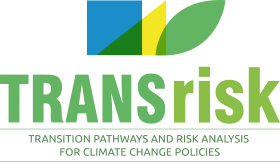Research often focuses on creating and modelling hypothetical scenarios. However, public knowledge and opinions are crucial for the successful uptake of research findings. In this article, we explore how quantitative tools are used for producing scenarios, whereas qualitative tools are used to identify stakeholder preferences.
In the TRANSrisk project, case studies are done to analyse low-emission transitions can be achieved within the domestic contexts of countries. For such analyses, both quantitative and qualitative analytical tools are used. For example, with help of models, positive and negative impacts of a low-emission pathway for the country can be assessed, thereby assuming implementation of clean technologies at a certain scale. Qualitative tools help to assess aspects that are more difficult to quantify, and therefore often not covered by models. An objective of TRANSrisk is to integrate quantitative tools with qualitative tools for improved analysis.
In order to practice with an integrated approach with qualitative and quantitative tools, the TRANSrisk team organised a training workshop in Athens (Greece) in March 2016. At this workshop, TRANSrisk partners took part in a roleplay session in which they acted as stakeholders in a decision-making process and were asked to respond to a respond to a research question, using H-diagram (see picture below) as qualitative and the MEMO model as quantitative tool (MEMO is a large scale, multisector, dynamic stochastic general equilibrium model, constructed by IBS in Poland for climate policy assessment). Based on stakeholders’ response, which reflected their positions, interests and preferences, additional research questions were formulated. For example, should energy efficiency be stimulated at a larger scale, what would be implications for employment in energy-intensive and other sectors? These additional research questions were discussed with the modeller, after which the model simulations could begin to explore answers to the questions raised. Answers were then presented to the stakeholders.
A next example of integrating stakeholder consultation with modelling has been applied by partners BC3 and JIN to explore how stakeholder engagement can support scenario development and pathway design for a low-emission and climate resilient future. For that, stakeholder preferences have been collected through an international stakeholder consultation (mostly representing international organisations). Stakeholders’ views as expressed via the survey have subsequently been used as an input for model-based scenarios. These scenarios will, in a next stage of the project, be communicated with stakeholders to see whether stakeholder opinions change after the results of the scenarios have been presented to them.
Another area in TRANSrisk where integration of qualitative and quantitative tools can produce enhanced insights is that of risk and uncertainty determination. In the case study analysis two categories are considered: risk that a low-emission pathway will not be (successfully) implemented (implementation risk); and the risk that a pathway may have negative impacts to the rest of society (consequential risks). Implementation risks could be assessed, for example, by using the qualitative, participatory tool of system mapping, which would help to identify potential system barriers and assess to what extent these barriers could imply a risk of unsuccessful implementation of the pathway. Models could also be used for assessing implementation risks, especially when these can be quantified, such as implementation costs. Consequential risks could be quantified using a model, thereby assuming a certain implementation scale of the pathways, after which qualitative tools can be used to assess the risks and their acceptability or not.
The potential complementarity of quantitative and qualitative tools for low-emission pathway development will be tested and evaluated in the TRANSrisk case study analysis. Quantitative tools are used, among others, for making business-as-usual scenarios and scenarios which assume achieving a longer-term climate and/or sustainable development goal, and assessing implementation of low-emission options as part of these scenarios. Qualitative tools are used for identifying stakeholder preferences, public acceptance of low-emission options and analysing systems and required system improvement for successful implementation of low-emission pathways.
Insights gained from TRANSrisk and its case studies can be helpful input for developing methodologies for Nationally Determined Contributions (NDCs), which are national climate plans that countries must communicate as part of the Paris Agreement. The method used in TRANSrisk for case study analysis has several similar similarities with the type of analysis that is required for formulating NDCs, as TRANSrisk takes the domestic context of a country as a starting point, considers desired socio-economic futures as a basis for low-emission pathways and conducts this analysis in a participatory manner with stakeholder engagement. Therefore, the TRANSrisk methods reflect the bottom-up approach taken by the Paris Agreement for formulating country climate actions towards the 2oC target.

The report can be downloaded from the TRANSrisk website.
TRANSrisk
Project details
- Project title: “Transitions Pathways and Risk Analysis for Climate Change Mitigation and Adaption Strategies” (TRANSrisk)
- Funding scheme: European Union Horizon 2020 Programme (EU H2020, grant agreement no. 642260)
- Duration: 3 years (1 September 2015 – 31 August 2018)
- Project coordinator: Science Policy Research Unit, University of Sussex, United Kingdom
- Project website: www.transrisk-project.eu



